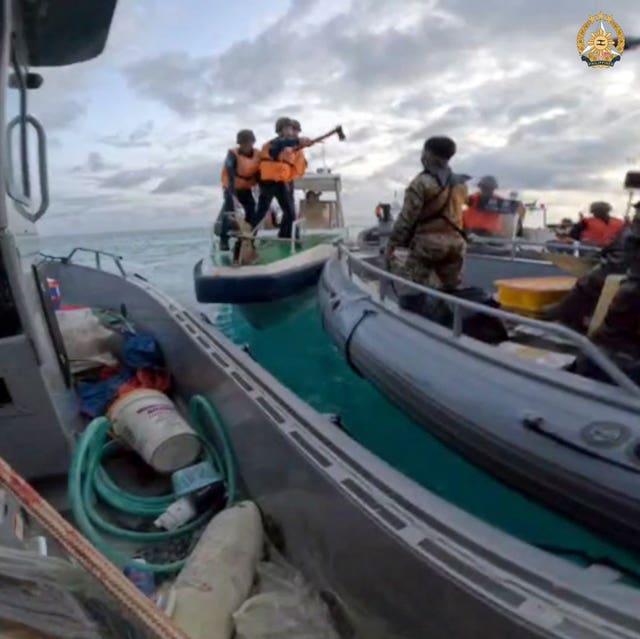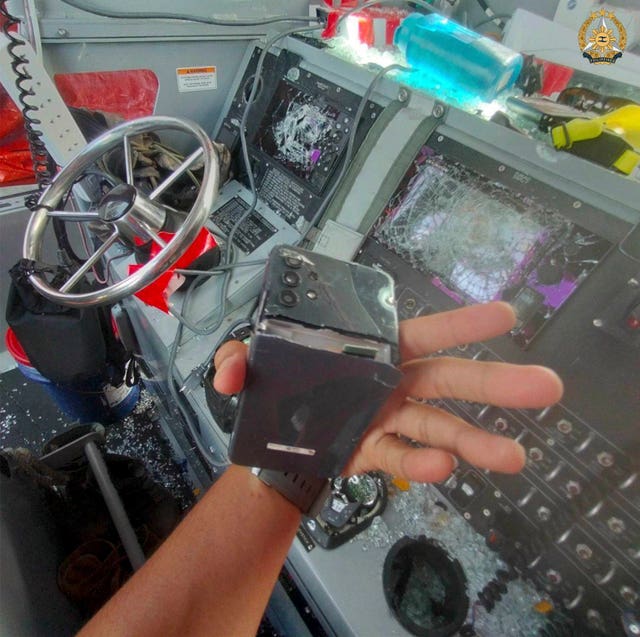
A Philippine military chief demanded on Wednesday that China return several rifles and equipment seized by the Chinese coastguard in a disputed shoal and pay for damages in an assault he likened to an act of piracy in the South China Sea.
Chinese personnel on board more than eight motorboats repeatedly rammed, then boarded, two Philippine Navy inflatable boats on Monday to prevent Filipino navy personnel from transferring food and other supplies, including firearms, to a Philippine territorial outpost in Second Thomas Shoal, which is also claimed by Beijing, according to Philippine officials.
After a scuffle and repeated collisions, the Chinese seized the boats and damaged them with machetes, knives and hammers.

They also seized eight M4 rifles, which were packed in cases, navigation equipment and other supplies. They wounded a number of Filipino navy personnel, including one who lost his right thumb, two Philippine security officials told The Associated Press on Tuesday.
The two officials spoke on condition of anonymity because of a lack of authority to discuss the sensitive conflict publicly.
Video and photographs issued by the Philippine military on Wednesday night show the chaotic faceoff at the shoal, with Chinese personnel onboard boats brandishing knives, axes and sticks while surrounding two Philippine navy supply boats beside Manila’s ship outpost.
Sirens blared constantly as both sides could be heard yelling at each other. The Chinese could be seen smashing the Philippine navy boat with a pole before grabbing what appeared to be a bag with a stick.
Pictures show a damaged Philippine navy boat with its side floaters slashed and deflated and another boat with its windshields and navigational screens shattered.
“We are demanding that the Chinese return our rifles and our equipment, and we’re also demanding that they pay for the damage they caused,” general Romeo Brawner Junior, head of the Philippine armed forces, said in a news conference in western Palawan province, where he pinned a medal on the wounded navy officer.
“They boarded our boats illegally and seized our equipment,” he said.
“They’re now like pirates with this kind of actions.”

Armed with long knives and machetes, the Chinese coastguard personnel tried to beat the unarmed Filipinos, who resisted with their bare hands by parrying the blows and pushing back the Chinese, Mr Brawner said.
“Our objective is also to prevent war.”
Some of the Chinese pointed their knives at the Filipino navy personnel, he said.
China blamed the Philippines for the confrontation, saying the Filipino personnel “trespassed” into the shoal in defiance of its warnings.
“This is the direct cause of the incident,” Foreign Ministry spokesperson Lin Jian said in Beijing.
“The Chinese coastguard at the scene has taken professional law-enforcement measures with restraint aimed at stopping the illegal supply mission by the Philippine vessels and no direct measures were taken against the Philippine personnel.”
On Tuesday, the United States renewed a warning that it is obligated to defend the Philippines, a treaty ally.
China claims the South China Sea virtually in its entirety.
There is fear that disputes in the South China Sea, long regarded as an Asian flashpoint, could escalate and pit the United States and China in a larger conflict.
In addition to China and the Philippines, Vietnam, Malaysia, Brunei, and Taiwan have conflicting territorial claims in the busy waterway.
Since last year, hostilities between China and the Philippines have escalated in the disputed waters, particularly in Second Thomas Shoal, which is less than 200 nautical miles (370 kilometres) from the Philippine coast and where the BRP Sierra Madre, now encrusted with rust, was deliberately grounded in 1999 to create a territorial outpost.
The ship remains an actively commissioned military vessel, meaning the Philippines could consider an attack on it an act of war.


Comments: Our rules
We want our comments to be a lively and valuable part of our community - a place where readers can debate and engage with the most important local issues. The ability to comment on our stories is a privilege, not a right, however, and that privilege may be withdrawn if it is abused or misused.
Please report any comments that break our rules.
Read the rules here